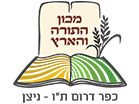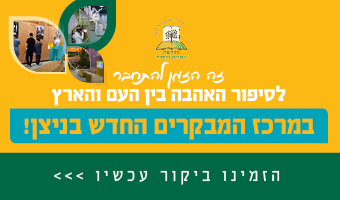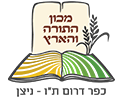The major turnaround in the miracle of Hanukkah cannot be summed up merely as the physical events—the Jews’ salvation from their oppressors and the nullification of the decrees. The fundamental transformation was the change in the generation’s spiritual state. This change was manifested by the nation’s attitude towards a Torah-lifestyle and by its ability to imbue its culture with a holy patriotism, a patriotism that fiercely opposed Greek Hellenism.
Rabbi Doron Vatkin, Heshvan-Kislev 5773
The major turnaround in the miracle of Hanukkah cannot be summed up merely as the physical events—the Jews’ salvation from their oppressors and the nullification of the decrees. The fundamental transformation was the change in the generation’s spiritual state. This change was manifested by the nation’s attitude towards a Torah-lifestyle and by its ability to imbue its culture with a holy patriotism, a patriotism that fiercely opposed Greek Hellenism. In short, the great revolution was that the Jews launched a spiritual battle against the culture that venerates the body and the material world, backed by Greek wisdom and philosophy. It is for this reason that the Berayta states (Shabbat 21b): “The next year these [days] were appointed a Festival.” The crux of the cultural battle continued long after the outright victory. The redemption of the Temple and its inauguration; its purification and the lighting of the Menorah; the miracle of the flask of oil, and the spiritual revival all constituted novel breakthroughs whose impression would be long-lasting among the Jewish People. This breakthrough was crucial, since the beautiful, enticing Greek wisdom planted its seeds in human culture and the Jewish people would have to continue battling the materialistic culture in the generations to come.
The next year the Hasmonean Beit Din was able to appreciate, in retrospect, the scope of the redemption and the salvation from the insidious influence of the secular culture that attempted to defile everything sacred to the Jewish People. The Sages then realized that they needed to appoint a holiday to commemorate this cultural victory for generations in order to carry on the influence of the holy culture epitomized by the Hasmoneans’ valor.
The Menorah’s moniker attests to the relationship between the victory and the generation’s spiritual state. It is called the “Pure Menorah.” The Torah, the source of everything, as well as the G-dly abundance emanating from the Temple, was located in the most sacred place: the Holy of Holies. There, inside the Holy Ark lay the Tablets and the broken Tablets alongside the Torah scroll that Moshe wrote, our eternal treasure. However, the influence of the Torah and its teachings in each generation were affected by the light of the Torah emanating from the Menorah. The Netziv (Naftali Zvi Yehuda Berlin), in his commentary on the Menorah (Exod. 25:31, s.v. “וְעָשִׂיתָ מְנֹרַת זָהָב טָהוֹר,” generally rendered as “fashion a candelabra of pure gold”), writes that the purity of the Menorah mentioned in the verse is not an adjective, describing the quality of the gold or the manner in which it was fashioned. Rather, it is a noun, that is, the Menorah was called the “Pure Menorah.” This was because it could properly illuminate its surroundings only when the generation was pure; the influence of the Menorah was commensurate with the generation’s receptacle—their ability to receive its spiritual light.
Each generation’s Torah learning, with its novel insights, further refines the Menorah’ light. When the Hasmoneans defeated the Greeks, G-d performed a miracle for them by illuminating the Menorah. The generation deserved it due to its burning desire to wage war against Greek culture, drawing strength from the Torah; this desire revived its patriotic and spiritual might. The ritually pure Kohanim spearheaded the rebellion, led by the High Priest Matityahu son of Yohanan. The source of holiness that shined through the depths of the Torah appeared and illuminated the Hanukah lights for generations.
According to the generation’s ability to draw up the oil onto the wicks, and to illuminate its surroundings, drawing on the Hasmonean source of purity and might, so too does the strength appear among the Jewish people to fight the attempt to erase the singularity of the Torah and its radiance. An ongoing battle rages between Greek and Jewish wisdom. Scientific culture disconnects from the resources of sanctity and attempts to divide and conquer: it acknowledges the existence of the profane world only, not of the Torah or of holiness. But not so the Jewish People, whom differentiate between the sacred and the profane:
But we know how to forge bonds, how to merge Heaven and Earth, and precisely using the sense of distinction, the sacred becomes sacred in its most perfect form […]. And we discern, so that never will rays of the profane blot out the richness of the sacred. […] The sacred guards its limits, it protects itself, so no profane stream can diminish its worth. And precisely by this protection does the sacred bestow life and also make room for the profane and its systems. […] We know that the eternity of the People of Israel is built on this differentiation between sacred and the profane, and in their combination in life. (trans. from Ma'amarei HaRa’iyah,essays by Rabbi Abraham Isaac HaKohen Kook, pp. 478-9)
עוד בקטגוריה נושאים נוספים
הכנת מאכלים ומשקאות חמים בשבת
בכל בית מצויים סוגים שונים של אבקות ותוספות המיועדות להכנה ולתיבול של מאכלים חמים בשבת. בחלקו הראשון של המאמר נביא את...
לא היו ימים טובים לישראל כט"ו באב
"יום שמחת ליבו", שהוא יום בניין בית המקדש, מתייחס ליום ט"ו באב העתידי. בו עתידה כנסת ישראל לצאת במחול לפני הקב"ה ולספר...






